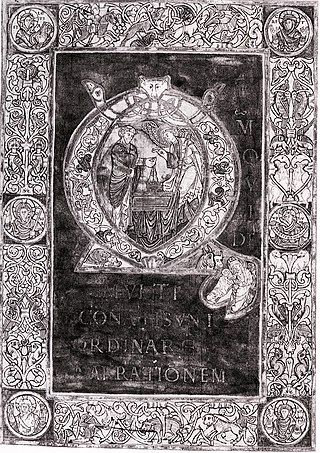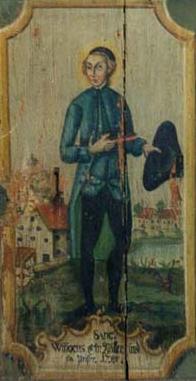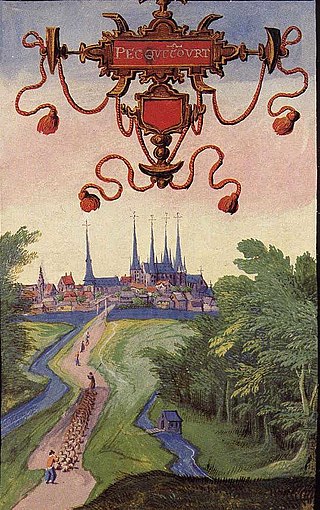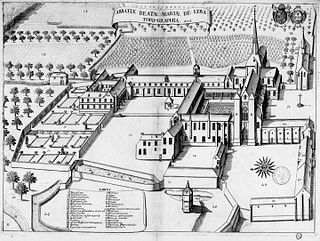
Bertin, also known as SaintBertin the Great, was the Frankish abbot of a monastery in Saint-Omer later named the Abbey of Saint Bertin after him. He is venerated as a saint by the Catholic and Orthodox Churches. The fame of Bertin's learning and sanctity was so great that in a short time more than 150 monks lived under his rule. Among them were St. Winnoc and his three companions who had come from Brittany to join Bertin's community and assist in the conversions. Nearly the whole Morini region was Christianized.

Bergues is a commune in the Nord department in northern France.

Fontenelle Abbey or the Abbey of St. Wandrille is a Benedictine monastery in the commune of Rives-en-Seine. It was founded in 649 near Caudebec-en-Caux in Seine-Maritime, Normandy, France.

Fleury Abbey (Floriacum) in Saint-Benoît-sur-Loire, Loiret, France, founded in about 640, is one of the most celebrated Benedictine monasteries of Western Europe, and possesses the relics of St. Benedict of Nursia. Its site on the banks of the Loire has always made it easily accessible from Orléans, a center of culture unbroken since Roman times. In 2010, the abbey had over forty monks led by the abbot Etienne Ricaud.

The Abbey of St Vaast was a Benedictine monastery situated in Arras, département of Pas-de-Calais, France.

Gembloux Abbey was a Benedictine abbey near Gembloux in the province of Namur, Wallonia, Belgium. Since 1860, its buildings host the University of Liège's Gembloux Agro-Bio Tech faculty and campus.

Winnoc was an abbot or prior of Wormhout. Three lives of the saint are extant. The best of them is the first life, which was written by a monk of Bertin in the mid-9th century or perhaps a century earlier.

Lobbes Abbey was a Benedictine monastery in the municipality of Lobbes, Hainaut, Belgium. The abbey played an important role in the religious, political and religious life of the Prince-Bishopric of Liège, especially around the year 1000. The abbey's founding saint is Saint Landelin; four other saints are also connected with the abbey.

Saint Godelieve is a Flemish saint. She behaved with charity and gentleness to all, accepting an arranged marriage as was the custom, but her husband and family turned out to be abusive. Eventually he had her strangled by his servants.

The Abbey of Saint Bertin was a Benedictine monastic abbey in Saint-Omer, France. The buildings are now in ruins, which are open to the public. It was initially dedicated to Saint Peter but was rededicated to its second abbot, Saint Bertin. The abbey is known for its Latin cartulary whose first part is attributed to Folcwin.

Anchin Abbey was a Benedictine monastery founded in 1079 in the commune of Pecquencourt in what is now the Nord department of France.

Marchiennes Abbey was a French monastery located on the Scarpe in Marchiennes. It was founded around 630 by Adalbard of Douai, and Irish monks, disciples of Saint Columbanus, on the advice of Saint Amand. One of its founders was Rictrude, who made it double monastery in 643. In around 1024 it became monastery of men again and adopted the Benedictine rule. On the birth of the town of Marchiennes the abbey became its economic motor until being suppressed in 1791 during the French Revolution. In 1814 all but its 1748 gatehouse was demolished. Its remains were inscribed on the inventory of monuments historiques on 17 May 1974,

The Abbey of Saint-Arnould, St. Arnold, Saint-Arnoult or Abbey of the Holy Apostles is a Benedictine abbey residing in Metz since the 6th century.
Bishop Alvise was a Bishop of Arras in the 12th century.

Ten Putte Abbey is a monastery with an abbey in Gistel, roughly 8 km to the south of Ostend, in the western part of Belgium. It was built to mark the spot where, in 1070, Saint Godelina was murdered by strangulation and then thrown into a pond. Before 2007 the abbey was home to nine Benedictine nuns, who were members of the wider Subiaco Cassinese Congregation in West Flanders. Since 2007 it has been occupied by brothers and sisters of the "Mother of Peace" community.

Guillaume d'Aure, OSB, was born in Toulouse, France and died on 3 December 1353 in Avignon. He was a French Benedictine monk and Cardinal. He was the son of Bernard VII Dodon, Count of Comminges, and Bertrande, Countess d'Aure, daughter of Arnaud, Vicomte de l'Arboust. He had a brother, Raymond Roger d'Aure.
Saint Folcwin or Folcuin was a Frankish abbot, cleric, and Bishop of Thérouanne.

Lyre Abbey was a monastery in Normandy, founded in 1046 at what is now the village of La Vieille-Lyre. From the mid-12th century it was a Benedictine house. It was abolished at the French Revolution and the abbey buildings mostly destroyed.
Mummolus was the second abbot of Fleury Abbey at Saint-Benoît-sur-Loire for 30 years between September 632 and January 663.

Hasnon Abbey was a Benedictine monastery, originally founded in the 7th century in Hasnon, near Saint-Amand-les-Eaux and Valenciennes in the department of Nord in France. It was reopened in 1065 as a Benedictine abbey under the instruction of Malbod, abbot of St. Amand. Baldwin VI of Flanders built a church nearby which was consecrated in 1070 and called St. Peter's of Hasnon. The abbey was reformed once again in the 15th century under Laurent d'Ivoire, abbot of Hasnon. During the French Revolution the structures forming the abbey were destroyed.

















